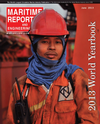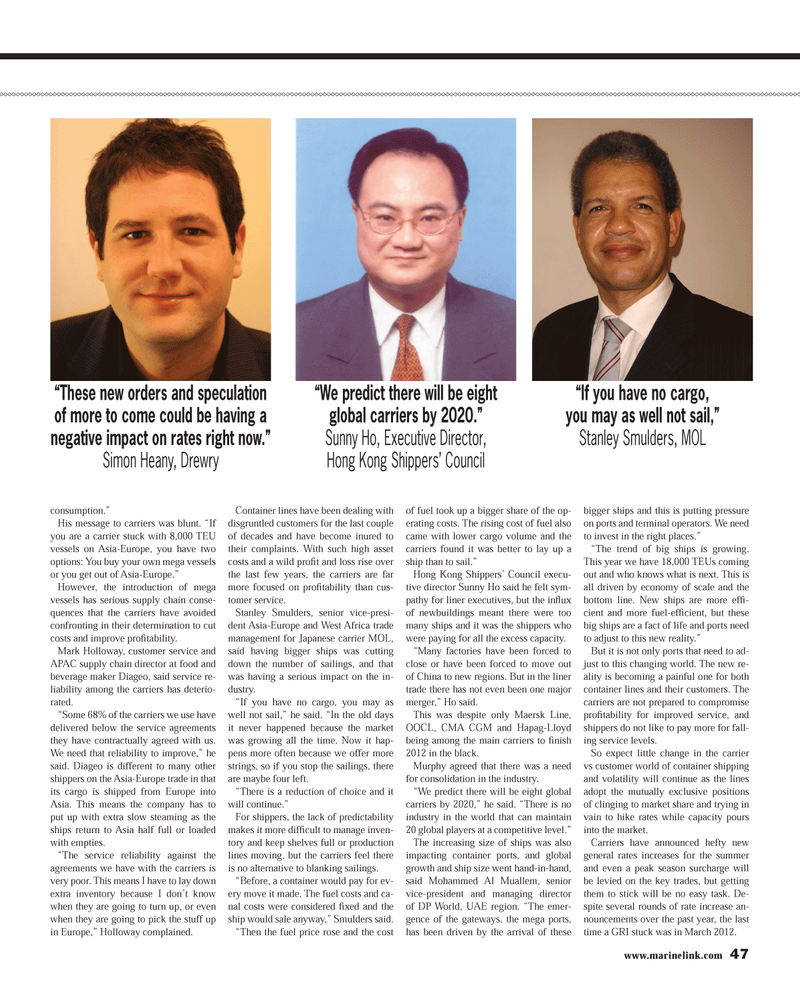
Page 47: of Maritime Reporter Magazine (June 2013)
Annual World Yearbook
Read this page in Pdf, Flash or Html5 edition of June 2013 Maritime Reporter Magazine
www.marinelink.com 47consumption.?His message to carriers was blunt. ?If you are a carrier stuck with 8,000 TEU vessels on Asia-Europe, you have two options: You buy your own mega vessels or you get out of Asia-Europe.? However, the introduction of mega vessels has serious supply chain conse-quences that the carriers have avoided confronting in their determination to cut costs and improve proÞ tability. Mark Holloway, customer service and APAC supply chain director at food and beverage maker Diageo, said service re-liability among the carriers has deterio-rated.?Some 68% of the carriers we use have delivered below the service agreements they have contractually agreed with us. We need that reliability to improve,? he said. Diageo is different to many other shippers on the Asia-Europe trade in that its cargo is shipped from Europe into Asia. This means the company has to put up with extra slow steaming as the ships return to Asia half full or loaded with empties. ?The service reliability against the agreements we have with the carriers is very poor. This means I have to lay down extra inventory because I don?t know when they are going to turn up, or even when they are going to pick the stuff up in Europe,? Holloway complained.Container lines have been dealing with disgruntled customers for the last couple of decades and have become inured to their complaints. With such high asset costs and a wild proÞ t and loss rise over the last few years, the carriers are far more focused on proÞ tability than cus- tomer service.Stanley Smulders, senior vice-presi-dent Asia-Europe and West Africa trade management for Japanese carrier MOL, said having bigger ships was cutting down the number of sailings, and that was having a serious impact on the in-dustry. ?If you have no cargo, you may as well not sail,? he said. ?In the old days it never happened because the market was growing all the time. Now it hap-pens more often because we offer more strings, so if you stop the sailings, there are maybe four left.?There is a reduction of choice and it will continue.?For shippers, the lack of predictability makes it more difÞ cult to manage inven- tory and keep shelves full or production lines moving, but the carriers feel there is no alternative to blanking sailings.?Before, a container would pay for ev-ery move it made. The fuel costs and ca- nal costs were considered Þ xed and the ship would sale anyway,? Smulders said. ?Then the fuel price rose and the cost of fuel took up a bigger share of the op-erating costs. The rising cost of fuel also came with lower cargo volume and the carriers found it was better to lay up a ship than to sail.?Hong Kong Shippers? Council execu- tive director Sunny Ho said he felt sym-pathy for liner executives, but the inß ux of newbuildings meant there were too many ships and it was the shippers who were paying for all the excess capacity. ?Many factories have been forced to close or have been forced to move out of China to new regions. But in the liner trade there has not even been one major merger,? Ho said. This was despite only Maersk Line, OOCL, CMA CGM and Hapag-Lloyd being among the main carriers to Þ nish 2012 in the black. Murphy agreed that there was a need for consolidation in the industry. ?We predict there will be eight global carriers by 2020,? he said. ?There is no industry in the world that can maintain 20 global players at a competitive level.?The increasing size of ships was also impacting container ports, and global growth and ship size went hand-in-hand, said Mohammed Al Muallem, senior vice-president and managing director of DP World, UAE region. ?The emer- gence of the gateways, the mega ports, has been driven by the arrival of these bigger ships and this is putting pressure on ports and terminal operators. We need to invest in the right places.??The trend of big ships is growing. This year we have 18,000 TEUs coming out and who knows what is next. This is all driven by economy of scale and the bottom line. New ships are more efÞ -cient and more fuel-efÞ cient, but these big ships are a fact of life and ports need to adjust to this new reality.? But it is not only ports that need to ad-just to this changing world. The new re- ality is becoming a painful one for both container lines and their customers. The carriers are not prepared to compromise proÞ tability for improved service, and shippers do not like to pay more for fall-ing service levels.So expect little change in the carrier vs customer world of container shipping and volatility will continue as the lines adopt the mutually exclusive positions of clinging to market share and trying in vain to hike rates while capacity pours into the market. Carriers have announced hefty new general rates increases for the summer and even a peak season surcharge will be levied on the key trades, but getting them to stick will be no easy task. De-spite several rounds of rate increase an-nouncements over the past year, the last time a GRI stuck was in March 2012. ?We predict there will be eight global carriers by 2020.?Sunny Ho, Executive Director, Hong Kong Shippers? Council?If you have no cargo, you may as well not sail,? Stanley Smulders, MOL?These new orders and speculation of more to come could be having a negative impact on rates right now.? Simon Heany, Drewry MR #6 (42-49).indd 47MR #6 (42-49).indd 475/30/2013 1:21:31 PM5/30/2013 1:21:31 PM

 46
46

 48
48
